Council on Environmental Quality Blog
Better Buildings Challenge Expands to Take on Data Centers
Posted by on September 30, 2014 at 5:00 PM EDTData center energy use has grown rapidly in recent years and is expected to continue to grow. In 2013, U.S. data centers consumed about 100 billion kilowatt-hours (kWh) of electricity, representing more than 2% of all U.S. electricity use. If all U.S. data centers were just 20% more efficient, we could save more than 20 billion kWh by 2020 as a nation. That translates to roughly $2 billion in cost savings.
That’s why the President’s Better Buildings Challenge is expanding to take on data centers with 19 new partners today. The Better Buildings Challenge was launched in 2011 to help American commercial, industrial, and multifamily buildings become at least 20 percent more energy efficient by 2020. Across the country, Better Buildings Challenge partners have completed upgrades to more than 9,000 facilities with 2,100 buildings improving efficiency by least 20 percent, and another 4,500 by at least 10 percent, compared to their baseline years.
The new partners joining the Better Buildings Challenge today include national laboratories; Federal agencies including the Environmental Protection Agency, the Department of Defense, and the Social Security Administration; as well as companies including CoreSite Realty Corporation, ebay inc., and Staples. For example, the Social Security Administration recently announced that its new national data center in Frederick, Maryland, will use about 30 percent less electricity than a typical data center.
These partners are pledging to improve the efficiency of data centers which altogether are currently consuming more than 90 megawatts of power:
- Argonne National Laboratory
- CoreSite Colocation Realty Corporation
- U.S. Department of Defense, Defense Information Systems Agency
- Digital Realty
- U.S. Department of Justice, Drug Enforcement Administration
- ebay, inc.
- Environmental Molecular Sciences Laboratory
- U.S. Environmental Protection Agency
- The Home Depot
- Lawrence Berkeley National Laboratory
- Los Alamos National Laboratory
- Michigan State University
- National Aeronautics and Space Administration
- National Energy Research Scientific Computing Center
- National Renewable Energy Laboratory
- Schneider Electric
- Social Security Administration
- Staples
- U.S. Department of Veteran Affairs
The Department of Energy will work with the data center owners and operators to improve efficiency when Challenge partners install emerging IT systems and technologies. Like all Challenge partners, the new data center partners will work with the Department of Energy to share publically their results and savings, which will be made available on the Better Buildings Challenge website.
Kate Brandt is the Federal Environmental Executive at the White House Council on Environmental Quality.
Learn more about Energy and EnvironmentFond du Lac Band leads climate resilience efforts on Lake Superior Chippewa Indian Reservation
Posted by on September 19, 2014 at 6:20 PM EDTLast Friday I had the pleasure of visiting the Fond du Lac Band of Lake Superior Chippewa Indian Reservation. I was joined by Raina Thiele, Associate Director of White House Intergovernmental Affairs, and Ann Marie Bledsoe Downes, Deputy Assistant Secretary at the Department of the Interior. We toured the reservation and facilities with tribal Chairwoman Karen Diver, a member of the President’s State, Local, and Tribal Leaders Task Force on Climate Preparedness and Resilience, and the Tribe’s Resource Management Division.
Over the course of the day, I visited Deadfish Lake, where the Tribe is working to restore wild rice harvests; Simon Creek, where the Tribe monitors hydrology; a newly installed bridge, which replaced a large stretch of road that had been washed out due to a major 2012 flood; and the Fond du Lac Ojibwe School’s community and journey gardens.
As a member of the President’s Task Force on Climate Preparedness and Resilience, Chairwoman Karen Diver is responsible for advising the Administration on how the Federal Government can better support communities across the country that are dealing with the impacts of climate change.
As a result of her efforts, and the efforts of her fellow tribal leader task force member, Mayor Reggie Joule of Alaska’s Northwest Arctic Borough, the Administration announced a new Tribal Climate Resilience Program to help tribes prepare for climate change at the fourth and final task force meeting. We look forward to continuing to work closely with Chairwoman Diver and tribal leaders across the country as they prepare for the impacts of climate change.
Mike Boots is Acting Chair of the White House Council on Environmental Quality.
Learn more about Energy and EnvironmentCelebrating a Milestone in Conservation – and the Law that Made it Possible
Posted by on September 19, 2014 at 4:52 PM EDTJust a few weeks ago, I was at the Smithsonian Museum of Natural History remembering an unfortunately dark moment in conservation history – exactly a century before, on September 1, 1914, the last known passenger pigeon died in a Cincinnati zoo. You can see “Martha,” as they called her, on display at the museum – stuffed, mounted and behind glass.
And now today, we mark an historic milestone of a far different sort on Maryland’s Eastern Shore. At Blackwater National Wildlife Refuge, Secretary of the Interior Sally Jewell and I were privileged to announce that thanks to concerted conservation efforts by area landowners and other partners, the Delmarva Peninsula fox squirrel has recovered from the brink of extinction.
So why did the passenger pigeon become extinct, while the equally common fox squirrel now thrives across much of its historic range?
The answer is simple. Unlike the passenger pigeon, the Delmarva fox squirrel was protected and aided in its recovery by the Endangered Species Act.
In fact, the fox squirrel was one of 67 species listed under the Endangered Species Preservation Act of 1967 and later extended protection by the federal law that succeeded it, the Endangered Species Act of 1973.
The successful recovery of the Delmarva fox squirrel is a testament to the dramatic benefits provided by the ESA. Prior to its protection, the species experienced a dramatic decline as the forests it depended on in the Delmarva Peninsula were cleared for agriculture and development. Its range was reduced by more than 90 percent, and in the mid-1960s there was a very real possibility that it would vanish entirely.
Yet here we are, less than 50 years later, with the Delmarva fox squirrel thriving again. And it wouldn’t have happened without the tools and protections provided by the ESA. Delistings like this one also remind how the Endangered Species Act can catalyze improvmements to natural habitats that promote ecosystem and community resilience in the face of a changing climate, and how it can be an incentive for community investment by improving regulatory predictability and providing certainty for people and businesses.
The ESA has been an unheralded gift to the nation — an expression of our deep desire to conserve biodiversity, the health of the habitat that sustains wildlife and humans alike, and our willingness to work for it. For more than 40 years, the law has been remarkably successful, preventing the extinction of more than 99 percent of the species listed as threatened or endangered since 1973. Its protections have helped the Fish and Wildlife Service and its partners reverse the death spiral of hundreds of species, while recovering dozens more. We can take enormous pride in the recovery of species such as the bald eagle, American alligator, Steller sea lion and other species against astounding odds – just like the Delmarva Fox Squirrel today.
If we want a world with polar bears, condors, and salmon, then we have to make deliberate choices to find a place for them. But as the Delmarva fox squirrel shows, it can be done.
If you could step back in time and prevent the extinction of the passenger pigeon, would you? If you answered yes, you have a historic chance to prevent many other equally senseless tragedies; to change the course of history by taking a stand, here and now in favor of species conservation.
The challenges we face today are daunting, but no more so than those faced by our ancestors a century ago. Like them, we need to have the courage to envision something better and grander than the status quo. Thankfully, we have the Endangered Species Act to help us bring people together across the landscape to make our shared vision of healthy, sustainable ecosystems for both wildlife and people a reality.
Dan Ashe is Director of the U.S. Fish and Wildlife Service.
Learn more about Energy and EnvironmentBiofuels and Our Clean Energy Future
Posted by on September 19, 2014 at 1:44 PM EDTToday at the White House, the Departments of the Navy, Agriculture and Energy announced new contracts to construct and commission biorefineries capable of producing drop-in, military-compatible fuels that can be used in our most advanced warfighting platforms and by commercial industry. Together, the three companies receiving the awards will produce more than 100 million gallons of military grade fuel – at a price that’s competitive with fossil fuel.
The awards, made under Defense Production Act (DPA) authorities, mark important progress on the President’s Climate Action Plan (CAP). The CAP calls upon the Administration to leverage partnerships between the private and public sectors to deploy cleaner fuels. It also specifically tasks the Departments of the Navy, Energy and Agriculture to work with the private sector to accelerate the development of cost-competitive advanced biofuels for use by the military and commercial sectors.
The biorefinery projects will be initiated this year, with fuel production expected to begin as early as 2016. That means American jobs that can’t be shipped overseas, and more progress toward replacing imported crude oil with secure, renewable fuels made here in the U.S. Emerald Biofuels will build a refinery on the Gulf coast that uses waste fats and greases; Fulcrum BioEnergy will build a refinery in McCarran, Nevada that utilizes municipal solid waste; and Red Rock Biofuels will build a refinery in Lakeview, Oregon that processes woody biomass.
This success story builds on previous efforts across the government to promote the development and use of advanced biofuels. The Navy has tested and certified their entire fleet to operate on these fuels and in 2012 demonstrated a carrier strike group during the Rim of the Pacific naval exercise in which all the air craft and conventional ships operated for two days on drop-in biofuels. Through its Biomass Crop Assistance Program and Loan Program, USDA has supported farmers and the construction of new advanced biofuel refineries including an algae biofuels project in New Mexico and a first of a kind commercial-scale cellulosic biofuel refinery in Florida. DOE has also been a major champion of advanced biofuel technology through the Bio Energy Technology Office and earlier this month celebrated the grand opening of the POET Project LIBERTY, the nation’s second commercial-scale cellulosic refinery.
Biofuels have an important role to play in fostering rural economic development and reducing greenhouse gas emissions from the transportation sector, all while increasing our energy security. Today’s announcement is an important step forward in accomplishing these goals, and in implementing the President’s Climate Action Plan.
Kate Brandt is Federal Environmental Executive at the White House Council of Environmental Quality.
Learn more about Energy and EnvironmentHow Climate-Resilient Schools Serve Students and Communities
Posted by on September 12, 2014 at 4:39 PM EDTEd. Note: This post introduces you to Commissioner Kristin Jacobs of Broward County, Florida.
Here in Broward County, Florida, we are blessed to enjoy a bounty of natural resources—from the unique Everglades on our western border, to the beaches and coral reefs of the Atlantic Ocean coast to our east. But we also recognize that our young people are a tremendous homegrown natural resource. We were delighted that the U.S. Department of Education came to south Florida on September 4 and 5 to recognize our Broward County Public Schools, a U.S. Department of Education Green Ribbon Schools District Sustainability Awardee, as part of its Green Strides Best Practices Tour celebrating schools that reduce environmental impact and costs, improve health and wellness, and teach environmental education. This celebration also helped to remind us that September is National Preparedness Month, an opportunity for local, state, and federal leaders to bring collective attention to the importance of emergency preparedness and resilience in our communities.
Broward County government has a long-standing partnership with the Broward County Public Schools, working to integrate environmental conservation and sustainable best practices into student education, educator training, and facilities management. While this collaboration has generated immediate benefits, promoted the sharing of technical resources, and supported a STEM-based curriculum, these joint investments have also furthered our regional efforts to build a climate-resilient community. Our efforts have involved the installation of drought-tolerant landscapes, expansion of native habitat into the urban landscape, establishment of edible school gardens, and promotion of resilient energy systems, along with comprehensive classroom and community discussions of climate, water issues, sea level rise, and the connection between our urban and natural landscapes.
As a member of the President’s State, Local, and Tribal Leaders Task Force on Climate Preparedness and Resilience, I have gained a heightened appreciation of the pressures that climate change poses to diverse communities across the nation. Cities, regions, and states all face community and economic risks from extreme weather and other hazards. As a nation, our ability to withstand these risks depends not only upon successful disaster preparedness planning, but also upon smart investments in community development, infrastructure upgrades, and even in the way we operate our schools.
As we celebrate National Preparedness Month, I would like to celebrate the leadership of President Obama in making climate resilience a focus of federal programs and activities. Working together, we can improve our communities’ security, economic health, and quality of life even in the face of climate impacts and natural disasters. Our natural resources—both our ecosystems and our young people—are counting on us to succeed.
Kristin Jacobs is Broward County Commissioner and a member of the President's State, Local, and Tribal Leaders Task Force on Climate Preparedness and Resilience.
Learn more about Energy and EnvironmentModernizing the National Environmental Policy Act: Taking Steps to Improve Efficiency
Posted by on August 22, 2014 at 10:30 AM EDTThe President takes seriously the need for efficient permitting and decision making by Federal agencies. This week, the Council on Environmental Quality (CEQ) is releasing for comment draft Programmatic NEPA Guidance to improve the efficiency and timeliness of Federal agencies’ environmental reviews under the National Environmental Policy Act (NEPA).
Since it was signed into law in 1970, NEPA has been a cornerstone of our Nation’s modern environmental protections, ensuring that Federal agencies make informed and transparent decisions when evaluating actions that could have an impact on the environment. NEPA also ushered in a new era of citizen participation in government, providing the public with transparent information about how proposed Federal agency actions will affect their communities and environment.
The draft Programmatic NEPA Guidance is part of the Administration’s broader efforts to expedite, modernize, and reinvigorate Federal agency implementation of NEPA. Specifically, the draft guidance will clarify opportunities to conduct efficient and thorough environmental reviews; assist agency decision makers and the public in understanding the environmental impacts from proposed large-scope Federal actions and activities; and encourage a more consistent approach to programmatic NEPA reviews.
Since President Obama took office, CEQ has taken a series of actions to ensure that NEPA reviews are timely, informative, and useful for advancing decisions that result in better outcomes for our communities and environment. These efforts include:
· providing new resources to assist Federal agencies in improving the efficiency of environmental reviews;
· working with Federal agencies through a pilot program to identify innovative approaches that reduce the time and costs required for effective implementation of NEPA regulations;
· improving conflict resolution practices; and
· integrating and aligning the NEPA environmental review process with other Federal and State environmental reviews.
Programmatic reviews assess the environmental impacts of actions associated with broad Federal programs or policies, avoiding repetitive analyses that would occur if each action were analyzed individually. Programmatic reviews may be followed by site-specific reviews, a process known as tiering, or they may serve as stand-alone NEPA reviews.
CEQ will continue to work to identify new ways to increase efficient agency decision making while reducing environmental impact. To view the draft guidance, visit www.whitehouse.gov/administration/eop/ceq/initiatives/nepa/programmatic-reviews.
Horst Greczmiel is Associate Director for NEPA Oversight at the White House Council on Environmental Quality.
Learn more about Energy and Environment
- &lsaquo previous
- …
- 2
- 3
- 4
- 5
- 6
- 7
- 8
- 9
- 10
- …
- next &rsaquo
White House Blogs
- The White House Blog
- Middle Class Task Force
- Council of Economic Advisers
- Council on Environmental Quality
- Council on Women and Girls
- Office of Intergovernmental Affairs
- Office of Management and Budget
- Office of Public Engagement
- Office of Science & Tech Policy
- Office of Urban Affairs
- Open Government
- Faith and Neighborhood Partnerships
- Social Innovation and Civic Participation
- US Trade Representative
- Office National Drug Control Policy
categories
- AIDS Policy
- Alaska
- Blueprint for an America Built to Last
- Budget
- Civil Rights
- Defense
- Disabilities
- Economy
- Education
- Energy and Environment
- Equal Pay
- Ethics
- Faith Based
- Fiscal Responsibility
- Foreign Policy
- Grab Bag
- Health Care
- Homeland Security
- Immigration
- Innovation Fellows
- Inside the White House
- Middle Class Security
- Open Government
- Poverty
- Rural
- Seniors and Social Security
- Service
- Social Innovation
- State of the Union
- Taxes
- Technology
- Urban Policy
- Veterans
- Violence Prevention
- White House Internships
- Women
- Working Families
- Additional Issues




